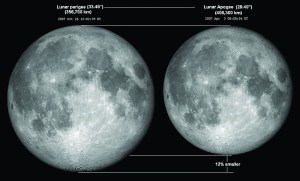
If you’re like me, you may not have heard the term “Supermoon” much before this year.
Maybe that’s because the term has only in the past few years been popularized by the media, but more likely because by the end of summer 2014, we’ll have had three of them, the final one occurring next week on Sept. 9.
That’s a lot of Supermoons in a short period of time. According to a Science Alert from the North American Space Agency (NASA), Supermoons happen on average every 13 months and 18 days. This is not infrequent when compared to other celestial events (Halley’s Comet orbits every 75 years), but three in a row is enough to really put the Supermoon on your sky-gazing radar.
Scientists refer to this phenomenon as a Perigee Moon, a term that describes the location of the moon in its orbit. The moon follows an elliptical path around the Earth, and is closer to the Earth at one end, Perigee, than the other, Apogee. If a moon becomes full on the same day it reaches Perigee, it’s then considered a Supermoon.
But how super is it? NASA says a Supermoon last year appeared “14 per cent bigger and 30 per cent brighter than other full moons of 2013.”
However, depending on where you are on Earth and what’s happening in the atmosphere, this difference in luminosity and size may or may not be detectable. Clouds or haze can mask differences in brightness, according to NASA, and when the moon is high in the sky, differences in size can be hard to measure.
Conversely, any full moon observed on the horizon can appear larger, even when not at Perigee, because of an effect called the “moon illusion.” When you add this effect to the already seemingly larger moon at Perigee, the results can be, well, pretty super.
The Supermoon of Sept. 9 is not predicted to be as bright as the one that occurred on Aug. 10, as it won’t be quite as close to the Earth.
However, with clear conditions, it still promises all the beauty and light any full moon provides, and perhaps a little more. For best viewing, snuggle up and watch the moon rise.
Niki Wilson
Special to the Fitzhugh
